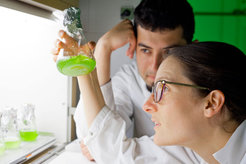Imagination and Innovation

(Prof. Dr. Lothar Willmitzer)
In the long run our goal is to develop a comprehensive, systems-level understanding of plant growth. To link plant growth and metabolism, the institute maintains a strong interest in understanding the genetic and physiological basis of biomass formation and heterosis. In addition, unique genetic resources have been developed to address another important hybrid effect relevant to plant growth: hybrid incompatibility. This research direction links plant physiology with evolutionary genetics and population genetics, and will close the gap between the research on growth and bioenergetics pathways in chloroplasts and mitochondria and the work on experimental genome evolution pioneered at the MPI-MP.
Current efforts are centred on unravelling a set of complex processes that are of particular relevance to plant biomass: the bio-energetic pathways, macronutrient acquisition, nutrient signalling and resource allocation.
Research: Strategy and Policy
To grasp the complexity, it is essential to determine molecular and complex parameters at different functional levels, and to analyse the complex data set against the background of existing biological knowledge.
Biomass acquisition is a highly complex process that is influenced by an enormous diversity of endogenous and exogenous factors. Macronutrient availability, uptake, distribution and storage of substances, the activities of the bioenergetics pathways and numerous abiotic factors, such as light, temperature and water availability and their impact on cellular growth play a major role in the growth of the plant. Developmental aspects of growth, like pattern formation, cell division rates, cell expansion and organ development interact with these factors. The institute has chosen metabolism as the point of entry to understand how plant growth is organised.
While the research strategies in the institute vary from group to group, they often involve one or more of the following complementary approaches:
- Reverse genetics is used with increasingly sophisticated methods to achieve spatially- or temporally-resolved changes in gene expression, and to optimally modify plastid gene expression at all levels
- Natural genetic diversity is used as a tool for multisite perturbation of complex networks, to search for metabolic phenotypes that may be predictors of complex traits like growth and heterotic yield gain, and to identify loci, genes and polymorphisms that contribute to the genetic regulation of metabolic traits
- Large time series or comparisons of multiple states are used during physiological or environmental perturbations
- Network analyses are used alone or in combination with published data, to identify candidate genes which then are subjected to detailed functional analysis
- Analyses of molecular and metabolic traits combined with studies of integrative trait

(Prof. Dr. Lothar Willmitzer)
Models and Predictions
One process that groups from all three departments have begun to tackle comprehensively at the systems level is photosynthesis as a key bioenergetic process in plants. The unicellular model alga Chlamydomonas reinhardtii was chosen for systems biology approaches. To work on the more complex problem of the relation between metabolism and growth in higher plants Arabidopsis is used, along with pilot projects on selected crops like maize and tomato.
The goal is to understand and ultimately model the complexity of photosynthesis and its interactions with other cellular metabolic networks and its dependence on the abiotic environment. This will eventually enable us to gather and ultimately model the relation between metabolism and growth.

